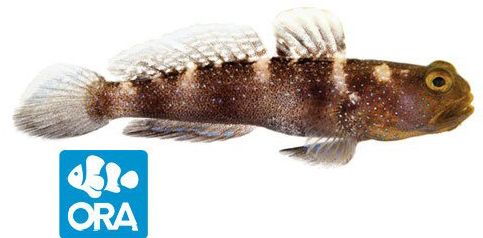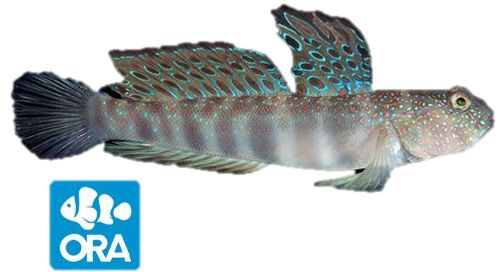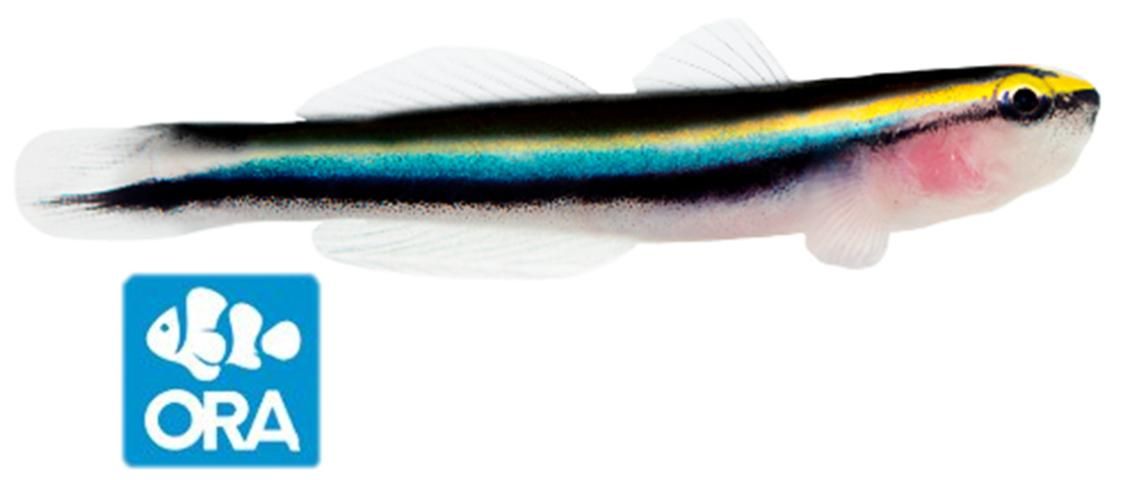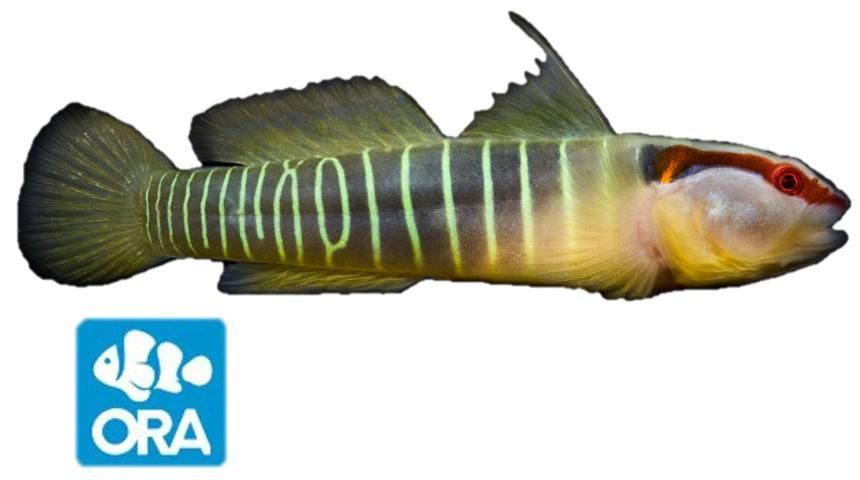Gobies are a common family of fishes in the marine aquarium hobby. Their diverse coloration and intriguing behaviors make them a welcome addition to most reef aquariums. Many goby species naturally perch on the rockscape or corals, spending their time out in the tank environment. These small fish are a great choice for first entries into reef keeping due to their hardy nature and ability to be housed with a variety of other species of fish. Several genera of gobies also provide valuable services to the aquarium; some clean other fish and others sift the sand bed. By volume (number of fish), the family Gobiidae represents the fourth most imported family of marine ornamental fish into the United States (Rhyne 2012). This demand has led to the development of culture techniques for numerous species within the family, and gobies have become a common offering among retailers of marine livestock.
This document covers important information that can be used by aquaculture producers interested in diversifying their business to include production of marine ornamental species. It highlights culture methods for members of the Gobiidae family and provides an overview of description and taxonomy, natural history, as well as diseases and marketing. More general information presented in this publication may be of use to the public or marine science and aquaculture educators.
Description and Taxonomy
Gobiidae is the most diverse family of marine fishes, comprised of over 2,000 species and growing. This family is dominated by small marine fish ranging from 25 to 75 mm and contains some of the smallest vertebrate organisms in the world. Some species can reach greater lengths, but these are not commonly aquacultured. The pelvic fins of gobies are characteristically fused together, an adaptation that helps them grasp onto corals, rocks, or aquarium glass in areas of heavy current. Coloration in this group ranges from camouflaging blacks, browns, and greens to vibrant oranges and yellows with identifying markings including vertical bars, which may be unique to species. Gobies have predominantly smooth bodies, some of which are scaleless. Certain species may secrete a toxic mucus that helps to ward off larger predatory fish (Schultz 2002). Two of the most popular genera of gobies currently cultured are neon or cleaner gobies (Elacatinus spp.) and watchman gobies (Cryptocentrus spp.). Other gobies in culture represent genera such as clown gobies (Gobiodon spp.), sleeper or sand sifting gobies (Valenciennea spp., Amblygobius spp.), and other watchman or shrimp gobies (Amblyeleotris spp., and Stonogobiops spp.). The term "goby" will be used throughout the paper to refer to members of the Gobiidae family. Examples of gobies cultured for retail are depicted in Table 1.
Cleaner gobies spend more of their time in the water column than the other goby species, which dwell on the sea bottom and rocky outcroppings. Cleaner gobies are relatively small (25 to 75 mm), with elongated torpedo-shaped bodies that are dark in color except for a neon stripe running down their sides. The color of these stripes varies from species to species. Cleaner gobies have small transparent fins, and their dorsal fins are split, with a rounded anterior fin and a flat posterior fin. This group of gobies is given the name "cleaner" because they actively remove parasites from other fish.
Sand sifting or sleeper gobies are usually larger, some reaching 150 to 175 mm long. They are normally found sitting on lagoon bottoms or among reef substrate. Their bodies are elongated, with colored blotches running the entire length. They have large, bucket-like mouths that scoop up sand and detritus and filter it for small invertebrates and leftover food.
Clown gobies are normally <75 mm long. Unlike other genera of gobies that create burrows in the sand, these gobies have an obligate relationship with the Acropora genus of corals. Clown gobies perch on the top of Acropora and live amongst the dense branches, hiding from predators. Studies have shown that gobies will protect their coral colonies from fish and plants alike, removing harmful plant life and chasing away fish attempting to feed on polyps of their host (Cole 2009; Dirnwoeber and Herler 2012).
Watchman or shrimp gobies are small and have a variety of species-specific color patterns. Some have distinctive striping patterns running down their sides, while others are solid in color. These fish have a symbiotic relationship with pistol shrimp (Alpheus spp.) in the wild. A shrimp creates a burrow for the pair to live in and, in turn, the goby watches for predatory fish from the burrow opening and warns the shrimp of danger. This relationship, while not necessary in the aquarium setting, is appealing to some hobbyists.
Natural History
Range and Habitat
Gobies are found throughout the world from cold to tropical environments. The species of importance in the aquarium trade are generally from tropical waters of the Indian and Pacific Oceans as well as the warm waters of the Western Atlantic. Their range includes the waters surrounding Japan, the Pacific islands of Fiji and Maldives, as well as the Caribbean and Gulf of Mexico. Temperatures in these areas generally range from 25 to 29°C, and salinity is relatively consistent (30 to 35 mg/L). These environmental conditions are generally recommended for home aquaria. Gobies make dens in small openings found throughout the lagoons or reefs they inhabit. Specifically, sand sifting gobies and shrimp gobies make burrows in sand or underneath rocks and corals, while clown gobies find a home in branching hard corals. These fish are territorial and rely on their dens for protection for themselves and their eggs. Most gobies do not travel far from their den and therefore need to find everything from food to mates within their territory to be successful.
Reproduction and Early Life History
Gobies have a diverse range of reproductive strategies. Most gobies reach sexual maturity quickly, with some species able to reproduce within several months of hatching. Generally, cleaner gobies maintain one sex for their entire lives (gonochoristic). Clown gobies are bidirectional hermaphrodites, meaning they can switch sex from male to female or female to male as needed, while other goby genera may be protogynous hermaphrodites, meaning they can switch sex from female to male only. Research has shown that it is more energy efficient for clown gobies to change sexes than to venture out of their home ranges to find another mate (Nakashima et al 1996). Reproductive pairs may spawn as frequently as every four days, and the females lay anywhere from 50 to several thousand adhesive eggs in a single spawning event. After fertilization, males guard the embryos and remove any that may become nonviable.
Embryo incubation time is species-specific and usually lasts from 4 to 10 days, depending on environmental factors such as water temperature. Newly hatched gobies are 1 to 3.5 mm in length depending on species. Clown goby larvae tend to be smaller, while cleaner gobies are typically 3 to 3.5 mm. All goby larvae, regardless of size, can eat small prey (~50 to 100 µm) immediately. Within three weeks of hatching, goby larvae are developed enough to eat larger planktonic organisms. Fry settle from the water column to the sea floor sometime after forty days post hatch. This "settlement" marks the end of their larval period. At settlement, the fish have completed their metamorphosis and should more closely resemble the adult phenotype. At approximately 90 days post settlement, gobies will be between 13 and 25 mm long and will be fully mature (Calado 2017).
Culture Techniques
Systems
Appropriate environmental conditions must be provided for captive propagation to be successful. In most culture facilities, access to "flow through" seawater is not an option, and multiple, separate, closed recirculating systems are required for culturing different life stages. Using these production practices requires a filtration system capable of removing excess food and waste from the water to prevent the accumulation of ammonia, nitrite, and other harmful compounds. Using a combination of mechanical and biological filtration helps reduce water-quality issues. Ample water flow is recommended for proper filtration and will vary based on the system size and stocking densities of fish. Use of ultraviolet sterilization or ozone can control harmful organisms like bacteria, parasites, and viruses. Environmental parameters should simulate the natural conditions gobies experience in the wild. Water temperatures should be kept between 25 and 28°C, pH between 8.0 and 8.3, and salinity at approximately 33 mg/L. Please refer to SRAC Publication No. 0451 and SRAC Publication No. 0452 for further information on engineering and operation of recirculating systems.
Broodstock and Spawning
Many gobies live in breeding pairs. Mating pairs can be selected by watching small groups of gobies for cohabitation of dens or courting behavior. This process may take minutes to days. During pairing, it is important to watch for aggressive behavior so that none of the broodstock are injured or killed. Once pairs are identified, they are transferred to individual 20- to 40-L tanks within a single recirculating system to allow spawning to begin. If multiple tanks are adjacent, cover the sides of the tanks or block them so that neighboring pairs of gobies do not become stressed or stimulated. It is not necessary to have Acropora coral or live rock in the tank for commercial breeding of gobies. Clay flowerpots have been used successfully as shelters and spawning substrates for these fish. Other options include PVC pipe, ceramic tiles, and rubble rock. Some gobies will even spawn on the walls of tanks when no suitable structure is available (Schultz 2002). In Figure 1, a yasha goby (Stonogobiops yasha) is guarding eggs that were laid inside of a PVC pipe.

Credit: Photo used with permission from Roger Williams University Aquaculture / Aquarium Science.
Spawning may begin a few weeks after a pair is formed and placed in the tank. Many genera of gobies exhibit social monogamy, so once paired, fish continue to mate. Increasing the amount of daylight hours in the light cycle may promote spawning; a minimum photoperiod of 12 light : 12 dark is recommended. Good broodstock nutrition will help to prepare or "condition" fish for spawning and provide the best chance for successful larviculture. Diets for broodstock fish should be comprised of a mix of high-quality, protein-rich foods (greater than 40% protein). Studies have shown a mixture of brine shrimp (Artemia spp.), mysis shrimp (Hemimysis anomala), and pellet-based foods are successful in conditioning cleaner goby species (Majoris et al. 2018) and similar diets are likely successful for use with other goby species. Broodstock should be fed multiple times a day to ensure nutritional needs are met.
Eggs and Larvae
Goby eggs are slightly elliptical in shape and approximately 1 to 2 mm in length and about 0.5 mm in width when laid. They are attached to the spawning material by filamentous strands. It is beneficial to prevent gobies from placing eggs on tank surfaces because removal can be difficult, and odds of mortality increase if eggs are dislodged. Eggs begin to darken after fertilization and become translucent shortly before hatching. Hatch times vary between species. Cleaner gobies can be expected to hatch about 7 days post spawn, while certain clown gobies have hatched as soon as 4 days post spawn. Factors such as water temperature, water quality, and amount of aeration and agitation all affect hatch rates.
Eggs can be left in the tank to hatch so that they can be cared for by their parents. While this practice may improve hatch rates in some instances, there are risks that should be considered. Larvae that hatch in broodstock tanks may be eaten by parents or lost to the filtration system. Moving eggs that are attached to substrate may be easier than capturing the moving larvae post hatch. Avoid handling eggs or larvae directly because it can increase mortality. Timing the hatch is key; leaving eggs in the care of parents for as long as possible reduces fouling. Eggs hatch within 24 hours of becoming translucent; this is a good cue to transfer them to larval tanks. It has also been noted in many species that hatching occurs a few hours after dark.
Larval tanks should be larger than the broodstock tanks, and production goals will dictate tank sizes and quantities. Eggs incubated in larval tanks should have a gentle, steady flow of water moving over them. This is important to mimic parental fin movements and increases survival and hatching rates for eggs. Devices such as air stones or small pumps can be used for these purposes.
Once hatched, larvae require live food, and options vary depending on size at hatch. Cleaner goby larvae are 3 to 3.5 mm in size, colorless, and active. They have little to no yolk reserves and should initially be fed rotifers (Brachionus spp.). Rotifers are one of the smallest live foods that can be offered to marine fish larvae and are used across many species as an initial feed choice. Enrichments, such as live or concentrated algae, are usually given to the rotifers to increase their nutritional value. Commercially available enrichment products are also available to improve the nutritional profile of rotifers and reduce costs associated with culturing live algae. Ensuring rotifers contain adequate concentrations and ratios of specific fatty acids will help to improve fish survival. Highly unsaturated fatty acids (HUFA), like docosahexaenoic acid (DHA) and eicosapentaenoic acid (EPA), are especially important and should be part of a quality rotifer enrichment. Direct addition of algae concentrates to the larval tank is an alternative enrichment strategy that has been used successfully with cleaner gobies (Majoris et al 2018). Some producers have also used 24-hour periods of light and elevated water temperatures during larviculture in an attempt to increase the feeding rates of the gobies. Results of such manipulations, however, have been variable and specific to species.
Larvae of clown gobies and Paragobiodon spp. are generally smaller than cleaner gobies and may require live feed organisms of a smaller size (smaller than 180 μm) (Wittenrich 2007; Calado 2017). Additional studies have shown increased survival rates during first feeding using small ciliates (Euplotes spp.), rotifers (B. rotundiformis), and enriched brine shrimp (Olivotto et al. 2005). As the larvae begin to grow, they can be gradually transitioned from smaller plankton to larger brine shrimp at about 7 days post hatch (DPH). The feeding regimen should have an overlap or "weaning" period that includes both types of live feed so that smaller individuals do not starve. As growth and development of the larvae continue, they can be weaned from live feeds to commercial microparticulate larval feeds. These commercial diets are normally introduced around the time of settlement.
The following is detailed information on development of cleaner gobies and can be used as a guideline for other goby species. Around 17 DPH, fins should be visible and developing along the body, and the fish should be less transparent. At 25 DPH, the body will deepen and become rounder. The stomach contents may be visible as a yellowish pink color, especially if the fish are eating brine shrimp. From 26 to 46 DPH and at ~9 mm in total length, metamorphosis will occur, and the fish will begin to move from the water column and settle to the bottom of the tank (Calado 2017). This marks the close of the larval period. Some clown goby species reach settlement as soon as 26 DPH, and cleaner gobies may take as long as 58 days. At this point in the life cycle, the fish are still fragile, which makes them especially susceptible to changes in the culture environment.
Growout
Once the gobies have metamorphosed, their fins should be present, their adult coloration begins to appear, and they are able to perch on the aquarium glass or substrate. At this time they should no longer be eating a live diet and may be given finely chopped seafood or commercial microparticulate diets. The introduction of pelleted feeds makes feeding much easier, compared to larval stages (Calado 2017). Water quality and filtration methods should be the same as previously described in the hatchery phase. Several gobies of one species can be kept in a tank together during growout provided they are kept at a density that limits aggression. Providing oyster shells, live rock, or other substrate for cover and perching will help keep stress levels low and limit competition for habitat (Schultz 2002). Figure 2 shows a large commercial growout system. Large cylindrical vats allow for greater numbers of juveniles to be cultured relative to smaller glass aquariums. Following metamorphosis, further growth occurs over the next 90 days, with some species reaching sexual maturity within that time. Species grow at different rates, with the smaller neon and clown gobies reaching a size of up to 25 mm during this period, while larger sizes can be expected from the watchman goby species. Once the gobies reach a marketable size they can be shipped and sold (Calado 2017).
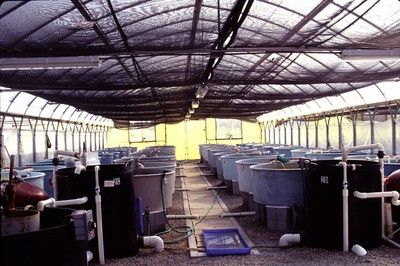
Credit: Photos used with permission from Oceans Reefs and Aquariums (ORA) (Ft. Pierce, FL).
Disease
Disease is a persistent concern for marine ornamental producers. Proper biosecurity measures must be taken to ensure pathogens do not spread unchecked through commercial aquaculture facilities. Cryptocaryon irritans and Amyloodinium ocellatum are two marine parasites that are commonly encountered and can lead to significant mortality of livestock. C. irritans, commonly known as marine ich, is a ciliated protozoan that can cause fish to appear thin, lethargic, and exhibit small "white spots" on their skin. For more information on identification and treatment of C. irritans, please refer to Yanong (2012). A. ocellatum, commonly known as marine velvet, is a dinoflagellate parasite that can have similar symptoms to C. irritans (Francis-Floyd and Floyd 2011). While these two parasites are somewhat common, a whole host of other protozoan, metazoan, bacterial, fungal, and viral diseases may affect fish in culture. Whenever new fish are incorporated into culture systems, a quarantine program should be implemented to reduce the chance of disease introduction into the established system. Fish should be monitored while in quarantine and only introduced into systems once they are deemed healthy. Adherence to strict quarantine and biosecurity protocols will help to minimize chances of major outbreaks of disease. Please refer to SRAC Publication No. 4707 and SRAC Publication No. 4708 for further information on developing biosecurity plans. It is always advisable to consult a veterinarian or aquatic animal health specialist for concerns regarding disease diagnosis and treatment.
Marketing and Economics
In 2017, it was estimated that at least 2 million people worldwide kept some form of marine aquarium and that at least half of those were in the United States. Opportunities exist to augment wild-capture fisheries with cultured products, and producers are hopeful this will continue to sustain and grow marine ornamental aquaculture into the future. Recent advancements in captive propagation techniques for marine ornamental fishes have led to increases in the number of species that can be commercially produced. Furthermore, ornamental fish are generally marketed on a "per fish" instead of a "per pound" basis, and thus may be more lucrative to culture compared with food fish.
The family Gobiidae has been a staple of the marine aquarium industry since its onset. Gobies are one of the top four most traded groups of fish in the United States, with up to 138 different species found in the hobby (Rhyne 2012). Being a small-bodied fish that can withstand a wide range of environmental parameters, gobies can live in a multitude of aquaria types, from small, 40 L aquariums to large, 400 L reef systems (Kurtz 2015). The family has great diversity in color, and several species exhibit interesting behavior that makes them a benefit to an aquarium.
Many species of gobies are already cultured, with cleaner gobies and watchman gobies (Cryptocentrus spp.) representing the most commonly produced genera. Retail prices for gobies are low relative to more rare species, but members of this family are in high demand. Individuals generally retail for $20 to $30 depending on size and species. Confirmed mated pairs can sell for even more. Aquacultured fish may be more apt than wild-caught fish to thrive on pellet and flake foods. This can make it much easier to keep them in a home aquarium, and thus cultured gobies may command a higher price than wild-caught fish. As research into broodstock spawning and larval feeding continues, the ability to successfully culture these fish will increase.
Conclusions
Aquaculture production of many ornamental marine species has recently increased, and the Gobiidae family is an excellent example of the success cultured fish can find in the marketplace. They have many qualities that make successful aquaculture feasible. Gobies reach market size rapidly and spawn quickly and reliably in captivity. With further research, culture of this family of fishes should only increase in efficiency and variety.
Suggested Readings
SRAC Publication No. 0451, Recirculating Aquaculture Tank Production Systems: An Overview of Critical Considerations
SRAC Publication No. 0452, Recirculating Aquaculture Tank Production Systems: Management of Recirculating Systems
SRAC Publication No. 0701, Culture of Small Zooplankters for the Feeding of Larval Fish
SRAC Publication No. 0702, Artemia Production for Marine Larval Fish Culture
SRAC Publication No. 5004, Phytoplankton Culture for Aquaculture Feed
SRAC 4707: Biosecurity in Aquaculture, Part 1: An Overview
SRAC 4708: Biosecurity in Aquaculture, Part 2: Recirculating Aquaculture Systems
All publications available at https://srac.tamu.edu/.
Sources
Calado, R., I. Olivotto, M. P. Oliver, and G. J. Holt. 2017. Marine Ornamental Species Aquaculture. Wiley Blackwell.
Cole, K. S. 2008. "Modifications of the Reproductive Complex and Implications for the Reproductive Biology of Gobiodon oculolineatus (Teleostei: Gobiidae)." Environmental Biology of Fishes 84 (3): 261–273. doi:10.1007/s10641-008-9433-8.
DiMaggio, M. A., E. M. Groover, G. J. van Senten, and M. Schwarz. 2017. "Species Profile: Clownfish." USDA Southern Regional Aquaculture Center Publication #7213.
Dirnwoeber, M., and J. Herler. 2012. "Toxic Coral Gobies Reduce the Feeding Rate of a Corallivorous Butterflyfish on Acropora Corals." Coral Reefs 32(1): 91–100. doi:10.1007/s00338-012-0947-3.
Francis-Floyd, R., and M. Floyd. 2011. "Amyloodinium ocellatum, an Important Parasite of Cultured Marine Fish." Southern Regional Aquaculture Center 1–12.
Majoris, J. E., F. A. Francisco, J. Atema, and P. M. Buston. 2018. "Reproduction, Early Development, and Larval Rearing Strategies for Two Sponge-Dwelling Neon Gobies, Elacatinus lori and E. colini." Aquaculture 483: 286–295. doi:10.1016/j.aquaculture.2017.10.024.
Nakashima, Y., T. Kuwamura, and Y. Yogo. 1996. "Both-Ways Sex Change in Monogamous Coral Gobies, Gobiodon spp." Environmental Biology of Fishes 46(3): 281–288. doi:10.1007/bf00005004.
Olivotto, I., A. Zenobia, A. Rollob, B. Migliarinia, M. Avellab, and O. Carnevali. 2005. "Breeding, Rearing and Feeding Studies in the Cleaner Goby Gobiosoma evelynae." Aquaculture 250(1-2): 175–182. doi:10.1016/j.aquaculture.2005.02.057.
Rhyne, A. L., M. F. Tlusty, P. J. Schofield, L. Kaufman, J. A. Morris Jr., A. W. Bruckner. 2012. "Revealing the Appetite of the Marine Aquarium Fish Trade: The Volume and Biodiversity of Fish Imported into the United States." PLoS ONE 7 (5). doi:10.1371/journal.pone.0035808.
Wittenrich, M. L. (ed.) 2007. The Complete Illustrated Breeder's Guide to Marine Aquarium Fishes. Neptune, New Jersey: TFH Publications.
Yanong, R.P.E. 2012. Cryptocaryon irritans Infections (Marine White Spot Disease) in Fish. FA164. Gainesville: University of Florida Institute of Food and Agricultural Sciences. https://edis.ifas.ufl.edu/publication/fa164

